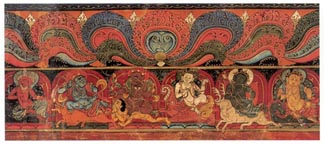| 44. Mandala of Mahavajrabhairava
|

44.
Mandala of Mahavajrabhairava
Central Tibet, second half of the 14th century
Distemper on cloth
81.3 x 71.8 cm (32 x 281/4 in.)
Pritzker Collection
click on image below for 44: Detail full screen view
|

44: Detail
|
|
This painting features Mahavajrabhairava (the Great Diamond-like Ferocious One), a wrathful aspect of the bodhisattva Manjushri. The god's nine heads are arranged in three tiers, with that of the peaceful Manjushri at the center of the upper tier. In his thirty-four hands he holds instruments signifying his awesome power; the uppermost pair of hands holds a flayed elephant skin - symbolizing the overcoming of ignorance - and the pair at his chest hold the skull cup (kapala) and chopper (kartrika). The sixteen-legged god is surrounded by a fiery halo whose tips are emblazoned with gold scrollwork. Mahavajrabhairava turns his gaze downward and to his left, as if to confront an unfortunate foe. His long orange hair sweeps upward like a fierce flame, forming a halo for his many heads, each crowned with a gruesome diadem of skulls. Delicate white bone ornaments adorn his chest, waist, ankles, arms, and neck, and the ithyphallic god wears a long necklace of severed heads. In the side registers are twelve aspects of Vajrabhairava embracing a consort. In the bottom register are the ten guardians of the directions (dikpala), all on fanciful mounts: Indra, Yama, Varuna, Kubera, Agni, Nairrti, Vayu, Ishana, Brahma, and Ananta; also, Panjara Mahakala and Yama, Lord of Death. In the top register are the celestial progenitor Vajradhara (at the center), Indian mahasiddhas, and Tibetan monks.
Mahavajrabhairava was known in an earlier iconographic form as Yamantaka (Destroyer of Death), and even in this form, he is sometimes known by this epithet.1 The bull's head and fierce countenance that he shares with Yama, Lord of Death, is the form he assumes in order to beguile Yama and quell his deadly deeds.2 Indian myth describes the origin of Yamantaka: An ascetic vowed to meditate for fifty years, after which he would achieve spiritual liberation (nirvana). Just one day before the end of his fifty years of austerities, robbers entered his cave with a stolen bull. As they decapitated the beast, one of the thieves suddenly saw the ascetic and realized that their crime had been witnessed. Although the ascetic explained his plight and begged them to spare his life, they showed him no mercy and ruthlessly removed his head as well. His lifeless body miraculously assumed Yama's powerful form; he placed the recently slaughtered bull's head on his shoulders, and his wrath knew no bounds. He killed the two thieves and drank their blood from cups made of their own skulls. It was only after the intervention of Manjushri in his form as Yamantaka that Yama's wrathful rampage was temporarily subdued. As in much of Esoteric Buddhist iconography, this deity, although apparently demonic and wrathful, is merely the manifestation necessarily assumed in order to achieve a compassionate goal.
And as with all wrathful Buddhist images, Yamantaka's fury could be harnessed for good. In Tibet, the famed theologian Tsong Khapa (1357-1419) designated Yamantaka as the protector of the Gelukpa order. He is sometimes associated with practices related to the "pacification of afflictions." In this context, Yamantaka
brings relief to those suffering from poverty, illness, or "assaults by demons."3 in many works, Yamantaka appears as part of the mandala's "protective sphere" (rakshachakra).4
Murals in the upper story at Gyantse (ca. 1425) include a Vajrabhairava mandala whose central figure
resembles the main figure here.5 This painting's iconography is also
similar to that in a painting in the Museé Guimet, Paris, and to another in the Los Angeles County Museum of Art.6 Both date to about the fifteenth century, slightly later than the work under consideration. In style, this work compares closely with two others in the exhibition: the Raktayamari (cat. no. 40), dating to about the early fourteenth century, and the Chakrasamvara (cat. no. 43), dating to about 1400. The extravagant, playful treatment of the lotus petals and the emphatically lobed tips of Mahavajrabhairava's flaming halo may be indications of a date later than that of the Raktayamari, and therefore sometime during the second half of the fourteenth century. The presence of Sakya-order monks (with long-tailed red peaked caps) in the painting's lineage suggests that it was commissioned for one of the Sakya communities in central Tibet. JCS
1. Linrothe 1999, p. 175. [back]
2. Beguin and Colinart 1995, p. 297. [back]
3. Lo Bue and Ricca 1990, p. 280. [back]
4. Mallmann 1964, pp. 111-16. [back]
5. Lo Bue and Ricca 1990, pp. 465, 469-70, pl. 182. [back]
6. Published in Béguin and Colinart 1995, pp. 297-98; and Pal 1983, p. 146, and New York,
Wisdom, 1991, pp. 282-83, respectively. [back]
|

